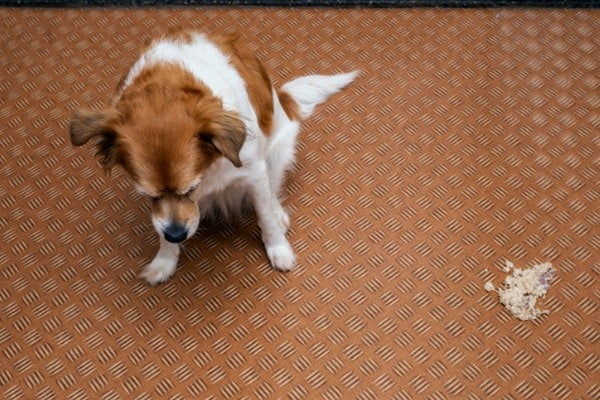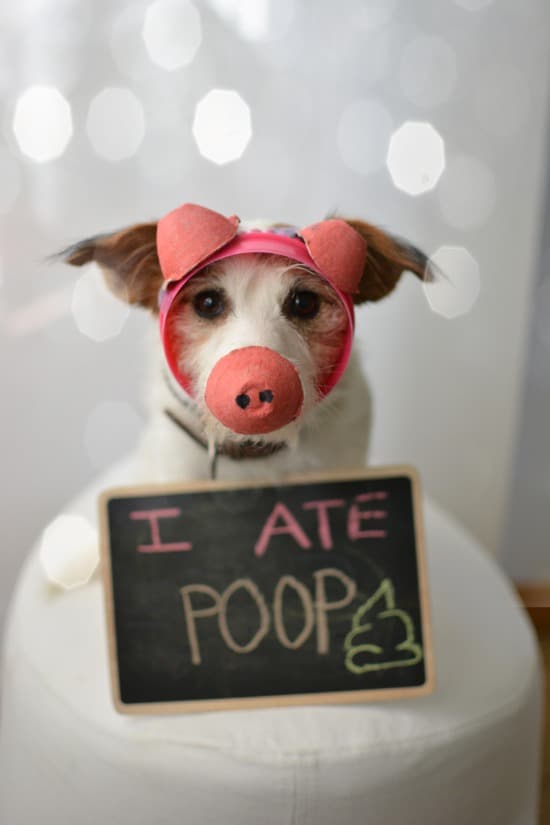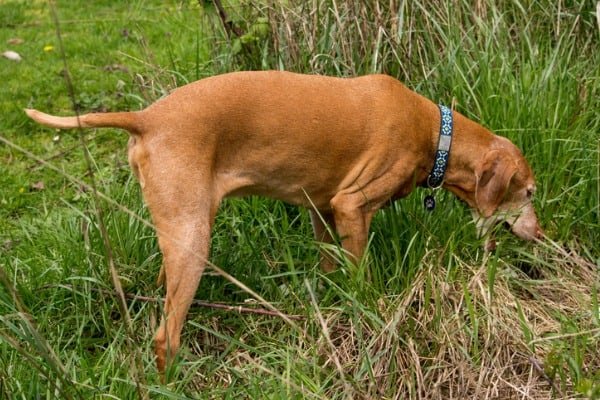
Puke is a fact of life when you have a dog.
Usually:
A dog vomiting has a benign explanation: car sickness, anxiety, mildly upset bellies, eating too much grass.
The situation is different and more concerning when dealing with foul-smelling dog vomit.
It’s gross, it’s not fun to clean, and the first thing that pops into your head is it’s not normal.
Be aware:
It’s indeed something you should not ignore if your dog is vomiting brown, smelly liquid.
Though not all instances need to be considered a medical emergency, there are some other symptoms you should look out for.
We’ll cover how this happens when you can address it at home, and when to head to the vet.
Warning: this is a nasty topic, and we recommend putting the snacks down for this one.
1. Bowel Obstructions

Has your dog had access to the cat’s litter box, their own waste, or other animal’s poop?
If not, then vomiting smelly liquid is a symptom of something serious.
If your dog’s sudden, smelly vomiting has no apparent explanation, you should take note of anything they might have eaten.
Abrupt and inexplicable vomiting that smells like poop is a sign that there is a dangerous obstruction somewhere in your dog’s intestines.
If you suspect this:
Time is of the essence, and the vet is the place to go.
What Could it Be?
Your dog might not be in the habit of eating their own poop or grazing from the cat’s litter box, but they might still have some bad eating habits.
Here’s some helpful info on natural ways to stop your dog from eating poop.
The condition known as pica causes dogs to eat non-food items – like fabrics, rocks, or paper.
Discouraging your dog and dog-proofing their space won’t only protect your belongings, it could also save your dog’s life.
It’s crucial to remember that dogs who have pica can eat anything.
If you think your basket of laundry is safe around your dog, think again.
It can be incredibly difficult to protect your dog from consuming something dangerous when they want to eat everything.
Some of the common items dogs with pica are drawn to include: clothes (especially when they smell like you), towels, bedding, toys, balls, carpeting, books, and toilet paper.
Dogs have swallowed even more unusual and dangerous objects, however.
Cases have been recorded where dogs ate batteries, balloons, and rubber ducks – even dangerously sharp objects like kebab skewers and light bulbs.
Clearly, a dog with this condition can’t be expected to make good choices when it comes to their odd snacking habits.
How does this lead to a dog throwing up poop?
The bulkier items on the menu are the ones more likely to cause a bowel obstruction.
Although swallowing anything non-food can be dangerous, larger items tend to cause smelly vomit as a warning sign.
Something like socks, fabric from bedding, or even a lot of toilet paper could become stuck in your dog’s bowels as their body tries to digest it.
If left untreated, intestinal strangulation will occur, which can be fatal in hours.
Err on the side of caution when you suspect an obstruction has occurred.
What to Look Out For?

First and foremost, pay attention to anything missing in your home.
If your dog had access to it, there’s a chance they ate it.
So if you’re 100% positive you left a pair of socks on the bathroom floor, and they mysteriously disappeared, you’ll need to keep a close watch on your dog for signs of distress.
Pica can cause dogs to experience diarrhea but still act fine; but don’t let loose stools lull you into a false sense of security.
Diarrhea can make its way around an obstruction and is in no way an all-clear that the object has passed.
That smelly, brown vomit is the next thing to keep an eye out for.
For obstructions higher in the intestines, the vomiting can be projectile but not otherwise unusual.
Lower obstructions can come with bloating and foul-smelling vomit.
This is an indication your dog’s digestive system is backed up, and it’s trying to purge itself.
Other symptoms include weakness, pale gums, lethargy, and refusal to eat or drink.
If your dog displays any of these symptoms, don’t waste time getting to a vet.
This is not something you can put off for a morning appointment.
Even if you aren’t sure your dog ate something, these symptoms should be addressed at the vet’s office.
You’d be surprised how sneaky dogs with pica can be – they can snatch something that you won’t notice is missing for days or weeks.
Several pet parents are shocked at the odd things the vet extracts from their dog’s intestines.
What’s the Prognosis?
If your dog has a bowel obstruction, the sooner they’re treated, the better.
A vet will determine the best course of action depending on the severity of the blockage and the nature of the object swallowed.
Some objects can be removed with an endoscope while your dog is sedated.
In other cases:
Surgery is required – such as when dealing with sharp objects or anything which has passed into the small intestines.
The outlook for recovery from surgery is good, but extra precautions are needed while your dog recovers.
Antibiotics and a short stay in the animal hospital will be required.
How to Prevent Bowel Obstructions?
The key to avoiding a health issue like this is to keep your dog from eating anything inappropriate or dangerous.
It’s easier said than done:
Especially when dealing with puppies and dogs with pica.
However, the time you spend dog-proofing your home is well worth avoiding a scary – and expensive – trip to the vet.
Out of Sight, Out of Mind
Anything your dog is attracted to needs to be secured away from them.
A closed-door between the dog and laundry – both dirty and clean – is a must.
Pay attention to what else tempts your dog and make sure they cannot reach it.
Dogs can be clever, and hiding things up high or in drawers doesn’t always work.
The better bet is to move things your dog can’t be trusted with to areas of the house they have no access to.
Or, keep things in locked cabinets and drawers.
Supervise, Supervise, Supervise
And for the pet parents in the back: supervise.
Many dogs with pica will learn that this behavior is not acceptable, and they’ll only do it when they’re not being watched.
Any time they are around things they might want to eat, keep a close eye on them.
Even dogs that eat things in the open will have less of a chance to do so if you’re right there to take away their unacceptable snack.
It’s especially important to supervise puppies, whether they have pica or not.
Most puppies eat foreign objects out of curiosity and because they don’t know any better yet.
Don’t underestimate what a puppy will put in its mouth – you have to be ready to snatch things away before they swallow them.
Both puppies and dogs with pica should always be crated when left alone.
Even if you leave them in a totally empty room, they sometimes manage to eat the flooring or the wall.
Offer Safe Alternatives
If your dog has pica or even has a bad habit of chewing things they ought not to, try supplying them with more toys.
Dogs with pica might try to eat the toy, too, so you’ll need to invest in durable ones that can withstand tough chewers.
Also:
Make sure the toys are far too big to swallow whole, because dogs with pica have been known to do that, too.
Chewy treats that are meant to be consumed aren’t the healthiest thing for your dog.
However:
In moderation, they’re a better alternative to the random junk your dog might otherwise try to eat.
Evaluate the Environment
Dogs with nutrient deficiencies might develop pica – the odd eating habits are an attempt to fill a nutritional void in their diet.
Thyroid issues, diabetes, and other imbalances in the body might be to blame.
Attempting to diagnose the cause of pica in a dog can include tests that rule out deficiencies or other medical causes.
The other common reason dogs develop pica is psychological distress. Separation anxiety and severe boredom can both lead to pica.
Dealing with the underlying stressors can help improve the condition and even eliminate it.
2. Eating Their Own Waste

When dog vomit smells like feces, sometimes the simplest explanation is the correct one: it’s because they ate their own feces.
Yes, a dog throwing up poop might have eaten their poop recently.
The question is, how do you tell the difference between this scenario and a bowel obstruction?
The nasty truth is that when a dog vomits up poop that they ate, it is frequently more solid with discernable shapes in the mix.
It can also happen very shortly after your dog eats this forbidden snack.
So, if you saw your dog eat their own poop, you can feel reasonably confident that’s why it’s in their subsequent vomit.
When in doubt, call the vet – it’s not worth it to take the chance when bowel obstructions are a possibility.
However:
If you have never known your dog to eat random things around the house, but have witnessed them eating poop, then it’s more likely they’re vomiting up poop, which has already passed once.
Why Do They Do It?
There are many reasons your dog might eat their own poop – otherwise known as coprophagia.
If your dog has ever had their face rubbed in an accident, they might eat their poop to “destroy the evidence.” In short, they’re trying to avoid being punished, even if they pooped outside.
Rescue dogs who have been abused previously are at risk for this behavior.
Malabsorption, parasites, and mineral deficiencies can also spark this weird, gross behavior.
Some dogs do it purely out of curiosity, although this is more frequently seen in puppies.
Other dogs might do it out of boredom or if they’re confined to a yard or dog run for long stretches.
How to Prevent the Behavior?
Putting a stop to your dog eating their poop – and sometimes throwing it back up – depends on why they do it in the first place.
Similarly to keeping a dog from eating foreign objects, limiting their access is a quick fix while you address the underlying cause.
A dog with coprophagia should not be left unsupervised in the yard where they have plenty of chances to do their business and eat it after.
Keep them on a leash for bathroom breaks. Clean and dispose of stools right away.
A vet can help evaluate if parasites or dietary imbalances are to blame. If that’s the case, anti-parasite medications and changes in food can solve the issue.
Dogs who experience coprophagia due to psychological issues should be handled with care.
Discouraging them from the behavior without scolding them is essential, especially for dogs who have been mistreated.
While you should never yell or hit them, a firm “no!” helps get the message across.
When you catch a dog or puppy about to feast on their poo, redirect them to something appropriate – a toy or a tempting snack.
Soon, they will learn the reward is greater when they leave the poop alone.
3. Eating the Waste of Other Species

Coprophagia also encompasses the habit of eating other animals’ stools.
A typical issue dog and cat parents face is the dog treating the litter box as a smorgasbord.
When your dog’s throw up smells like poop, and you have a cat in the house, the litter box should be high on your suspect list.
Eating stool is enough to upset the stomach of any dog and cause them to throw it up.
Toss in cat litter as a garnish, and you have the recipe for an upset dog tummy and some disgusting vomit.
Fragrances and chemicals in cat litter can cause vomiting and other health issues.
Even natural cat litter can be dangerous, as it can swell and cause bowel obstructions.
It can be tricky to deal with if your dog eats cat poop and happens to consume a lot of litter.
Their smelly vomit can indicate a simple upset stomach or the bowel obstruction we talked about earlier.
If you think your dog is vomiting because they dove headfirst into the litter box, watch out for the other signs of bowel obstructions: weakness, loss of appetite, pale gums, and lethargy.
If your dog shows signs of distress, you know the vet is the next step.
However, sometimes it’s just the fact that they ate cat poop that turns their tummy and causes foul-smelling poop.
The best solution?
Lock up the litter box. Luckily, things like cat doors and gates work to separate your dog from the litter box without blocking your cat from their toilet.
When Good Dogs Eat Bad Things
If your dog is throwing up brown liquid and smells, it could be the sign of something serious.
Familiarizing yourself with the signs of bowel obstruction, as well as your dog’s habits of eating random objects, will help you recognize an emergency.
A dog throwing up poop might have simply eaten poop.
Knowing if this is the case also requires keeping a close watch on your dog’s behavior.
The causes of dogs throwing up poop have several different solutions and preventive measures.
The trick is to determine the root cause.
Once you do that, you can work towards your goal of never having to clean up poop-vomit again.
